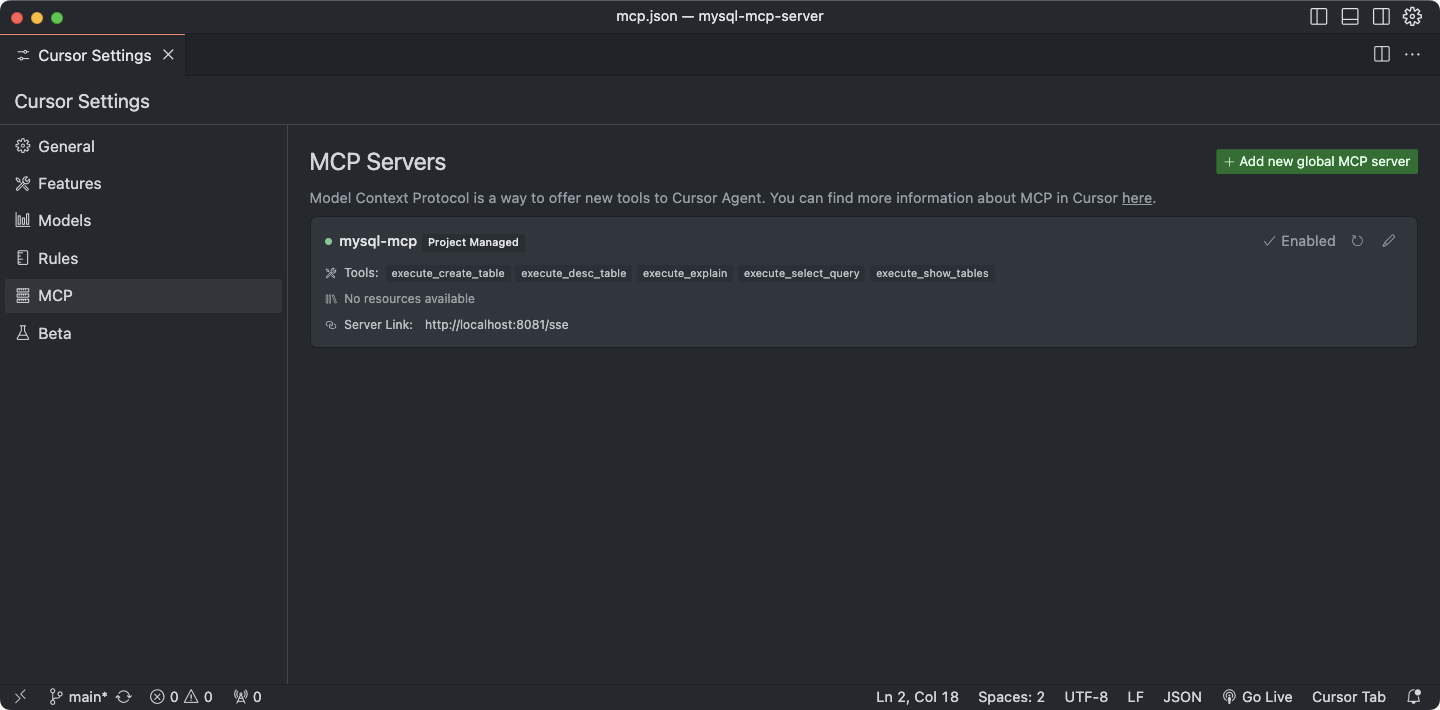mysql-mcp-server
0. Execution
Running with Docker
Change the database connection information as needed.
docker run -d --name mcp-mysql \
-e MYSQL_HOST=localhost \
-e MYSQL_PORT=3306 \
-e MYSQL_USER=root \
-e MYSQL_PASSWORD=mcpTest1234!!! \
-e MYSQL_DATABASE=mcp_test \
-e MCP_PORT=8081 \
-p 3306:3306 mineru/mcp-mysql:1.0.0
Running with Docker Compose
This will proceed with a pre-configured setup.
docker-compose up -d
Running directly with Python
pip install -r requirements.txt
python mysql_mcp_server/main.py run
Cursor Configuration
MCP functionality is available from Cursor version 0.46 and above.
Additionally, the MCP feature is only accessible to Cursor Pro account users.

Tool Addition Tips
- Adding a Tool
executefunctions implement the actual logic execution (Service Layer).- The
@tooldecorator helps register the tool with MCP (Controller Layer).
- Explanation
- Each file under
mysql_mcp_server/executorsrepresents a single tool. - If a new tool is added, it must be imported in
mysql_mcp_server/executors/__init__.pyand included in the__all__array. - This ensures the module is automatically registered in the
TOOLS_DEFINITIONvariable.
- Each file under
flowchart LR;
A[AI Model] -->|Request tool list| B[MCP Server]
B -->|Return available tools| A
A -->|Request specific tool execution| B
B -->|Call the corresponding executor| C[Executors]
subgraph Executors
C1[execute_create_table] -->|Create table| D
C2[execute_desc_table] -->|View table schema| D
C3[execute_explain] -->|Query execution plan| D
C4[execute_insert_query] -->|Execute INSERT query| D
C5[execute_insight_starter] -->|Checking the schema for building reports| D
C6[execute_invoke_viz_pro] -->|Visualization chart recommendations| D
C7[execute_select_query] -->|Execute SELECT query| D
C8[execute_show_tables] -->|Retrieve table list| D
end
D[DatabaseManager] -->|Connect to MySQL| E[MySQL 8.0]
E -->|Return results| D
D -->|Send results| C
C -->|Return results| B
B -->|Return execution results| A
🚧 Development Roadmap 🚧
⚙️ Parameter Options
- 🔧 Enable/Disable Switch for Each Tool: Provide a function to reduce Input Context costs 💰
- 🔒 Query Security Level Setting: Offer optional control over functions that could damage asset value, such as DROP, DELETE, UPDATE 🚫
✨ Features
- 📊 Data Analysis Report Generation: Provide a report generation function optimized for the model to appropriately select various charts based on user requests 📈
- 📝 Reporting capabilities for prescribed forms
- 🖌️ Diversify report templates
- 🗄️ Extended Text2SQL Support
- 🌐 SSH Connection Support: Enable secure remote access via SSH for advanced operations 🔑
- 📥 File Extraction Function
- 📄 CSV
- 📑 JSON
- 📉 Excel
- 📊 Data Analysis Report Generation: Provide a report generation function optimized for the model to appropriately select various charts based on user requests 📈
1. Overview
MCP MySQL Server is a server application for MySQL database operations based on MCP (Model Context Protocol). This server provides tools that allow AI models to interact with the MySQL database.
2. System Configuration
2.1 Key Components
- MCP Server: A FastMCP server that communicates with AI models
- MySQL Database: Manages and stores data
- Tools: Executors that perform database operations
2.2 Tech Stack
- Language: Python
- Database: MySQL 8.0
- Key Libraries:
- mcp: Implements Model Context Protocol for AI communication
- PyMySQL: Connects to MySQL and executes queries
- pandas: Processes and analyzes data
- python-dotenv: Manages environment variables
- fire: Implements command-line interfaces
2.3 Deployment Environment
- Containerized deployment via Docker and Docker Compose
- Ports: 8081 (MCP Server), 3306 (MySQL)
3. Directory Structure
MCPBoilerPlate/
├── mysql_mcp_server/ # Main application directory
│ ├── executors/ # Database operation executors
│ │ ├── create_table.py # Tool for creating tables
│ │ ├── desc_table.py # Tool for viewing table schema
│ │ ├── explain.py # Tool for query execution plans
│ │ ├── insert_query.py # Tool for INSERT query execution
│ │ ├── insight_starter.py # Schema verification tools for write reports
│ │ ├── invoke_viz_pro.py # Tool for Visualization chart recommendation
│ │ ├── select_query.py # Tool for SELECT query execution
│ │ └── show_tables.py # Tool for retrieving table lists
│ ├── helper/ # Utility modules
│ │ ├── db_conn_helper.py # Manages database connections
│ │ ├── logger_helper.py # Logging utilities
│ │ └── tool_decorator.py # Tool decorator
│ └── main.py # Application entry point
├── docker-compose.yml # Docker Compose configuration
├── Dockerfile # Docker image build settings
├── requirements.txt # Dependency package list
└── .env.example # Example environment variables file
4. Architecture Design
4.1 Layered Structure
- Interface Layer: MCP Server (FastMCP)
- Business Logic Layer: Handlers and Executors
- Data Access Layer: Database connection and query execution
4.2 Key Classes and Modules
- MySQLMCPServer: Main server class that initializes and runs the MCP server
- DatabaseManager: Singleton pattern-based database connection manager
- Executors: Collection of tools for database operations
- execute_create_table: Creates tables
- execute_desc_table: Checks table schema
- execute_explain: Provides query execution plans
- execute_insert_query: Executes INSETR queries
- execute_select_query: Executes SELECT queries
- execute_show_tables: Retrieves table lists
4.3 Communication Flow
- AI model requests a list of available tools from the MCP server.
- The server returns the available tools list.
- The AI model requests the execution of a specific tool.
- The server calls the corresponding executor to perform the database operation.
- The execution results are returned to the AI model.
5. Scalability and Maintenance
- Adding Tools: Implement new tools in the
executorsdirectory and register them in__init__.py. - Environment Configuration: Manage environment variables via the
.envfile. - Logging: Ensure consistent logging using
logger_helper.
6. Deployment and Execution
6.1 Local Execution
# Setup environment
cp .env.example .env
# Modify .env file as needed
# Install dependencies
pip install -r requirements.txt
# Run the server
python mysql_mcp_server/main.py run
6.2 Docker Deployment
# Start database using Docker Compose
docker-compose up -d db
# Build and run mysql-mcp-server with Docker Compose (including rebuilds)
docker-compose up -d --build mysql-mcp-server
7. Security Considerations
- Manage database credentials via environment variables.
- Use strong passwords in production environments.
- Consider implementing SSL/TLS encryption for database connections when necessary.